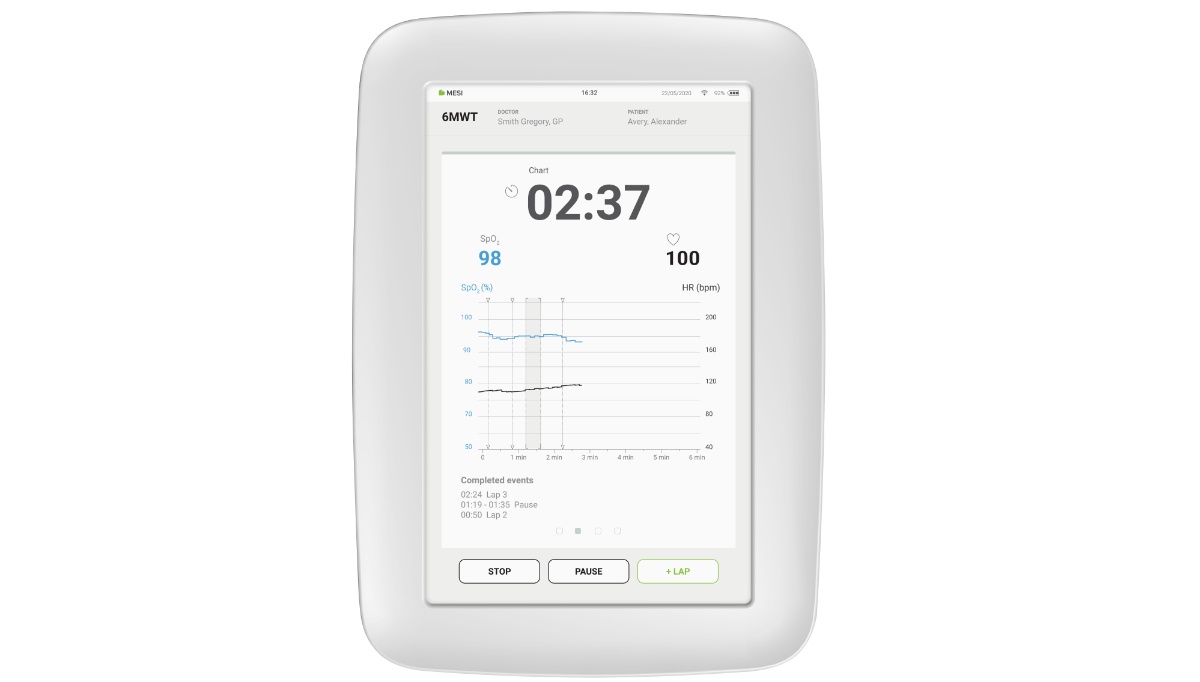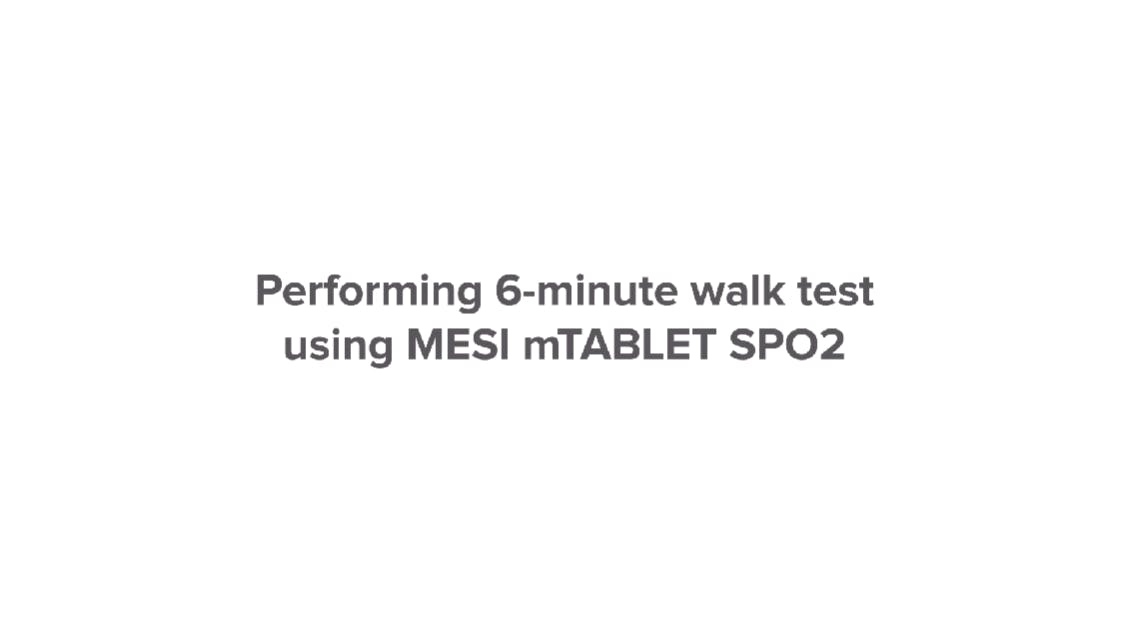The 6-minute walk test (6MWT) in assessing respiratory function
Pulmonary health is nowadays, in the light of the COVID-19 pandemic, more important than ever and many are at risk due to diseases connected to the respiratory system. Smokers are particularly at risk as are those with lung damage due to environmental pollution or exposure to dangerous chemicals. However, there are many other pulmonary conditions that require accurate diagnosis, timely intervention and management, and periodic examinations to determine the progress of the disease.

In this blog you will learn:
Why is the 6-minute walk test (6MWT) useful and for what purpose?
How is the 6-minute walk test (6MWT) used in pulmonary issues?
How is the 6-minute walk test (6MWT) used in patients with COPD?
How is the 6-minute walk test (6MWT) used in patients with COVID-19?
Why is the 6-minute walk test (6MWT) useful and for what purpose?
The 6-minute walk test (6MWT) was originally developed for assessing exercise tolerance in patients with cardiopulmonary issues, but has quickly found use in patients with a wide variety of other non-cardiopulmonary conditions, including complex neuromuscular and neurological diseases like multiple sclerosis (MS) [1-5]. In short, the 6MWT is often the go-to method for convenient and inexpensive assessment of general functional capacity but has little diagnostic value for specific organ groups involved in physical exercise. In other words, the 6MWT can only indicate improvement or deterioration of functional capacity due to disease.
How is the 6-minute walk test (6MWT) used in pulmonary issues?
In case of pulmonary conditions, the 6MWT is indicated in patients waiting for lung transplantation and cystic fibrosis [6, 7, 8]. It is also useful for evaluating post-surgical mortality in patients who were recipients of lung resection and severity of pulmonary arterial hypertension (PAH), a complex cardiopulmonary condition that is difficult to treat and manage [9, 10]. However, its severity is (fortunately) not matched by prevalence as is the case for another pulmonary disease that is the third leading cause of death worldwide [11].
We are talking about chronic obstructive pulmonary disease (COPD). Rising tobacco smoking rates and air pollution in low- and middle-income countries are the principal causes of this worrisome trend in addition to general ageing of the population [11, 12, 13, 14]. COPD is already the third leading cause of death worldwide (after cardiovascular diseases) and is even projected to rise to the first place in the next decade [11, 15]. High prevalence is matched by high morbidity and high cost of treatment and loss of productivity which convert to $2.1 trillion in global economic cost of COPD [16].
Patients with COPD suffer significant reductions in quality of life and functional capacity, particularly those with comorbid conditions of cardiovascular nature [17]. Psychological comorbidities are also common. Patients with COPD are at an increased risk of depression, particularly those with severe COPD – reported prevalence rates range from 24.6% to 27.1% [18, 19, 20]. Combination of these psychological and physiological factors makes treatment and management even more challenging and complex. Fortunately, not all diagnostic or therapeutic tools are expensive.
How is the 6-minute walk test (6MWT) used in patients with COPD?
There are several established methods for assessing functional capacity in patients with COPD, but virtually none as convenient and cost-effective as the 6MWT, which is used to evaluate the effectiveness of pulmonary rehabilitation measures, therapeutic interventions, and following the progress of the disease. Studies have demonstrated that even initial poor 6MWT distance is associated with increased mortality in the 3-year period since examination in patients with severe COPD and several comorbidities [21]. This should come as no surprise since exercise capacity is closely correlated with survival rates in those with COPD [22, 23].
Diagnostic value of the 6MWT is particularly apparent in patients with severe COPD who cease to have significant changes in their FEV 1 (the volume of air that can forcibly be blown out in first 1 second, after full inspiration the volume of air that can forcibly be blown out in first 1 second, after full inspiration). Lastly, there is a correlation between the 6MWT and perception markers of poor health, expanding its usefulness beyond evaluation of physical limitations by encompassing psychological and emotional components of the disease [25, 26, 27]. Comprehensive nature of the 6MWT aside, even just detecting silent hypoxia, can be extremely useful in triaging patients with the insidious respiratory condition that currently fills headlines and unfortunately also mortuaries.
How is the 6-minute walk test (6MWT) used in patients with COVID-19?
Much has been written about COVID-19 and undoubtedly even more will be in the near future given the novelty of the disease and a number of still-to-be-researched variables that impact the risk of infection and severity of the disease. What is known for now is very concerning, apart from high mortality, particularly in regard to long-term complications, including severe fatigue, muscle weakness, cognitive issues, and damage done to the lungs and heart in those who have recovered from the acute phase [28, 29].
Effective treatment and management of those patients as well as critical cases in the acute phase, proves mysterious – in the absence of accurate prognostic tools and biomarkers [30]. However, the 6MWT might be one of the tools to resolve this. A limited preliminary study found that the 6MWT in conjunction with SpO2 measurement is a useful tool for diagnosis of symptomatic exercise-induced hypoxia in hospitalized patients prior to planned discharge [31].
The 6MWT is a valuable assessment tool for evaluating progress of pulmonary diseases through improvement or worsening of walking distance and should be used as a part of comprehensive examination and monitoring programme for each patient.
How to perform 6-minute walk test (6MWT) using MESI mTABLET SPO2.

Interested in finding out more about the use of the 6MWT in the management of other conditions? Read about assessing heart failure, assessing pulmonary arterial hypertension and assessing the functional fitness of seniors.